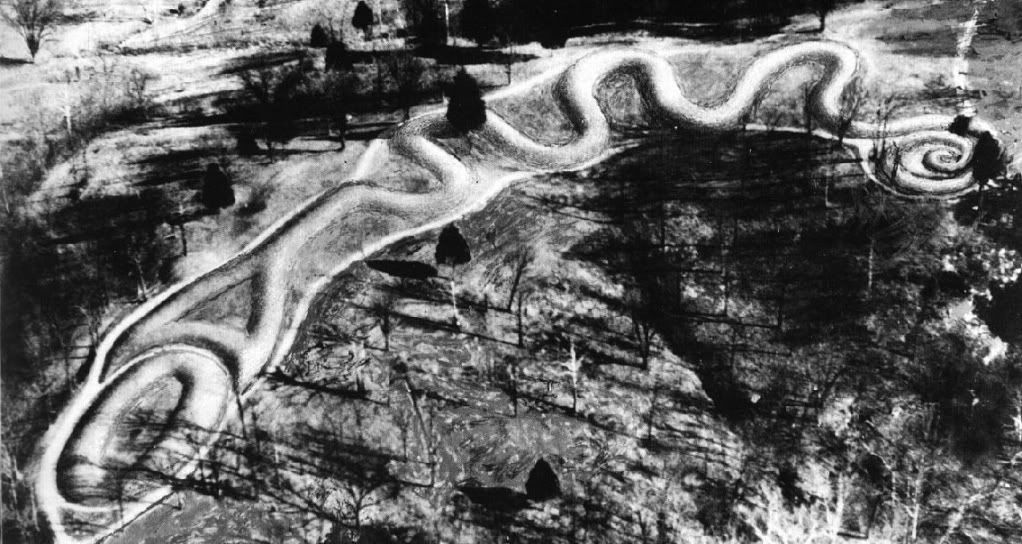On their own, the Indians were engaged in the great agricultural revolution that other peoples in Asia, Europe, Africa were going through about the same time. (18)Zinn proceeds to observe the contrast between the "egalitarian communes" of hunter-gatherers with the development of "divisions of labor among men and women," the rise of priests and chiefs, and other aspects of the cultures of settled populations of agriculturalists. Although he hints of an underside of the development of agriculture, his focus notes the achievements of civilization in the Americas prior to the European invasion.
He dwells less upon the differences between "nomadic hunters" and agricultural peoples in the Americas than upon describing social relations among the Haudenosaunee (he uses the term League of the Iroquois). Zinn describes property values and gender relations in such as way as to support a generalization.
So, Columbus and his successors were not coming into an empty wilderness, but into a world which in some places was as densely populated as Europe itself, where the culture was complex, where human relations were more egalitarian than in Europe, and where the relations among men, women, children, and nature were more beautifully worked out than perhaps any place in the world. (21)Zinn mentions in passing the Moundbuilder Culture, but omits discussion of their religion--some form of sun worship,--and neglects elaboration of its hierarchical arrangements aside from the passing phrase, "more surplus to feed chiefs and priests" (18-19).

Just as he faults Samuel Eliot Morison, Zinn opens himself to criticism. He observes that Morison's Christopher Columbus, Mariner (1954) mentions genocide as a consequence of policies initiated by Columbus, but then moves on to emphasize positive achievements. Zinn opines:
To state the facts, however, and then to bury them in a mass of other information is to say to the reader with a certain infectious calm: yes, mass murder took place, but it's not that important--it should weigh very little in our final judgements; it should affect very little what we do in the world. (8)As Morison quickly brushed past the issue of genocide, Zinn brushes past the hierarchical arrangements and theocratic states that emerged along the trail of corn in order to romanticize the American Indian past.
Pandora's Seed
Spencer Wells does not romanticize Neolithic peoples in Pandora's Seed: The Unforeseen Cost of Civilization (2010). Wells presents data from a 1984 study of skeletal remains in the eastern Mediterranean by J. Lawrence Angel that demonstrates substantive indices of health decrease--pelvic inlet depth, average stature, and median life span--during the Mesolithic (9000-8000 BCE), Early Neolithic (7000-5000 BCE), and Late Neolithic (5000-3000 BCE). Wells notes similar patterns in the Americas, "the data shows that the transition to an agricultural lifestyle made people less healthy" (24).
How can we explain the massive increase in human population and the dominance of agriculture, which has pretty much completely replaced hunting and gathering in every inhabited corner of the world, when it didn't improve people's lives? (24)It would seem that hunter-gatherers had an evolutionary advantage, yet agriculturalists prevailed. How was this victory achieved?
Although Wells poses this question, his focus concerns more centrally the long-term consequences of the Neolithic upon modern society, including the impact of a carbohydrate based diet upon general health and even how such changes so long ago contribute to global climate change. Along the way, however, he discusses the work of William H. McNeill (Plagues and Peoples [1976]) and Jared Diamond (Guns, Germs, and Steel [1997]). These works address how peoples from Europe prevailed over peoples in the Americas. Although the Neolithic Revolution transformed the Fertile Crescent, MesoAmerica, and southern China approximately the same time, the revolution in the Americas was principally plant oriented, while elsewhere domestication of animals proceeded apace. From these animals came the diseases that devastated the Indians when Europeans arrived.
People's versus Patriot's
Although Zinn skirts past the unpleasant side of the Neolithic Revolution in the Americas to advance his excoriation of the heroes of conquest, Larry Schweikart and Michael Allen take a different tact. A Patriot's History of the United States (2004) draws upon other studies that document deleterious effects of the Neolithic Revolution to argue for an insignificant demographic impact of the European invasion. There is no need to repeat here all that I have written concerning the claims of Schweikart and Allen and how they distort the science they cite. I address elements of their fantastic edifice in "Larry Schweikart's Claim" (looking at his History News Network plug for the book), "Footnote to Larry Schweikart's Claim" (examining his source, The Backbone of History, and how he distorts its findings), and "Death in Jamestown" (investigating A Patriot's most outlandish claim). "Origins of Malaria" adds some solid science to the refutation of Schweikart's claim that malaria originates in America.
I note in "Origins":
Civilization made us sick, but it also made us more numerous so we could impose our will on those otherwise more fortunate. The maladies that afflicted Europeans contributed in significant measure to their global expansion.As a working hypothesis, I am prepared to put forth the claim that Zinn's history distorts through conscious and open bias that romanticizes Indians, while Schweikart and Allen distort either through abysmal scholarship or through flagrant dishonesty.




No comments:
Post a Comment